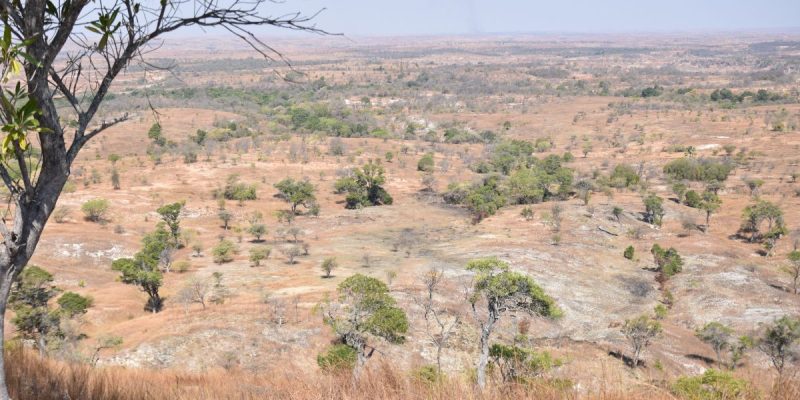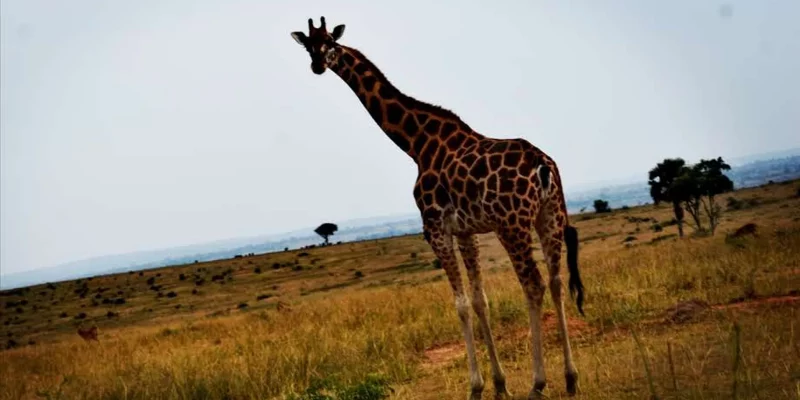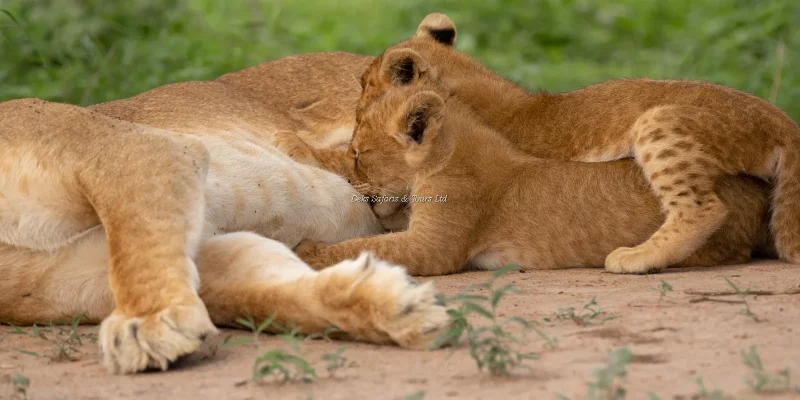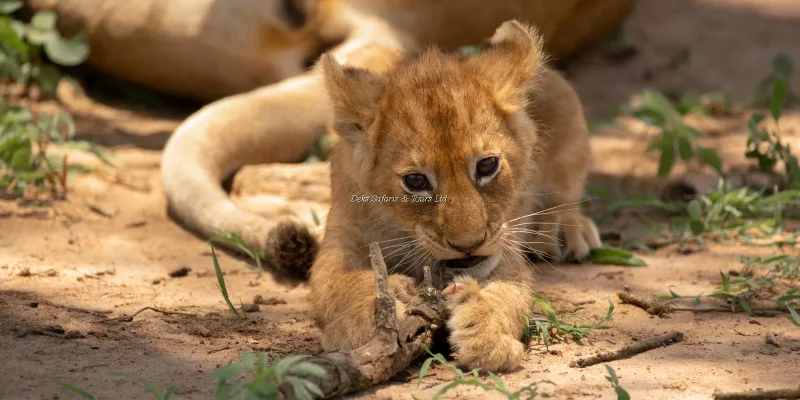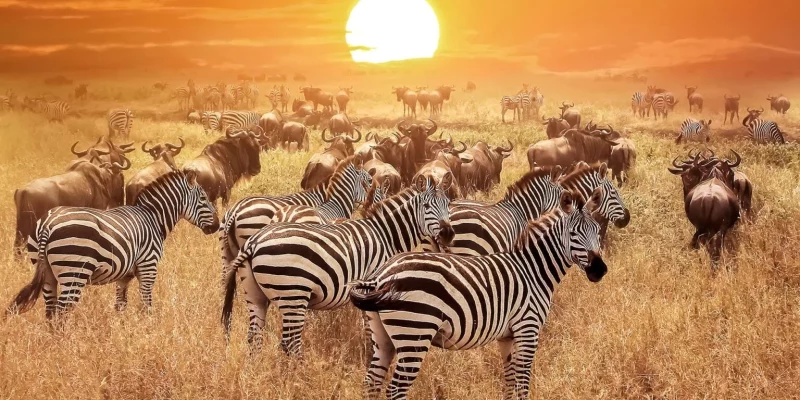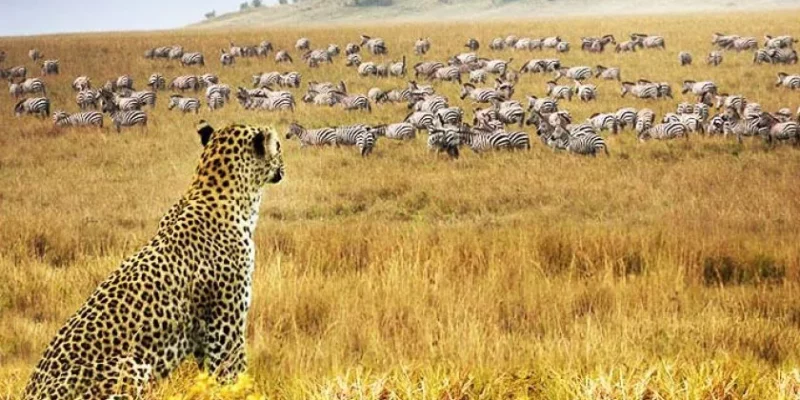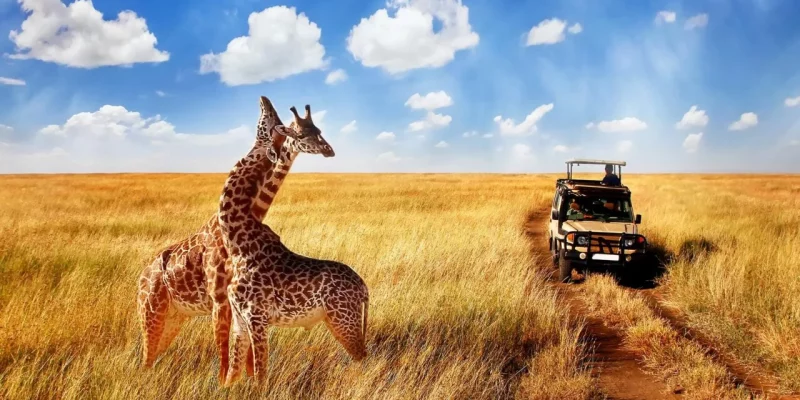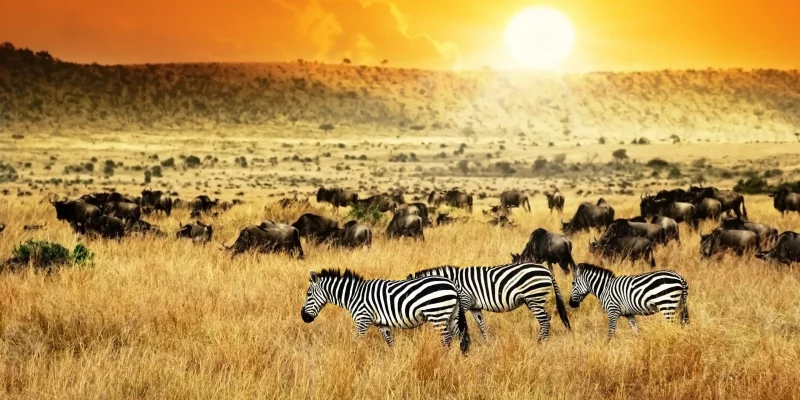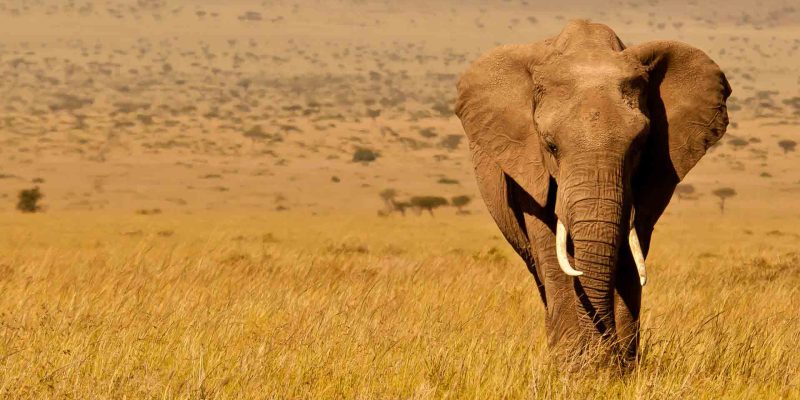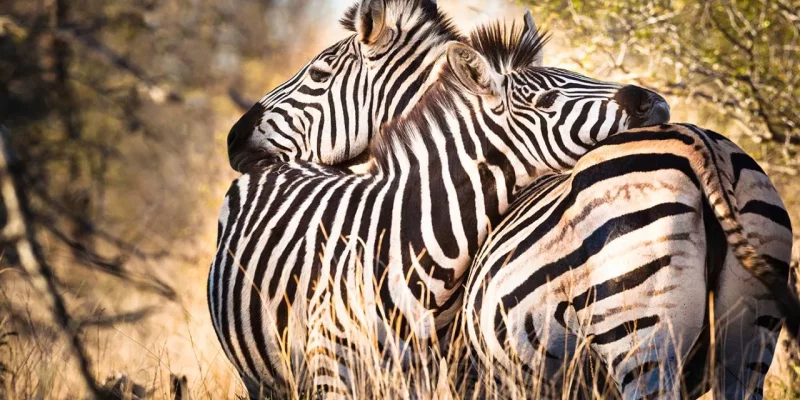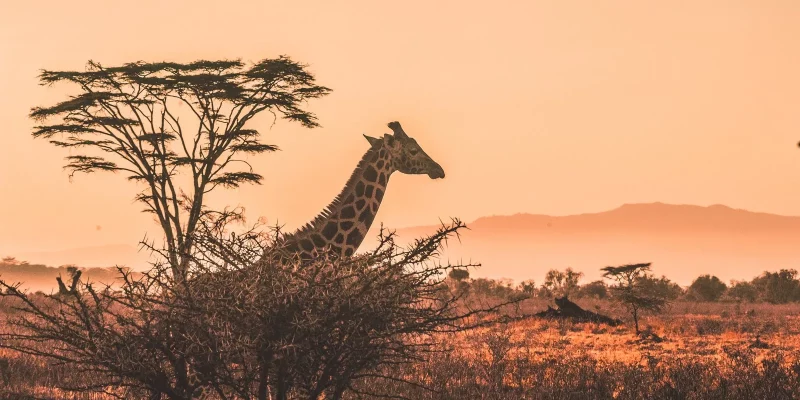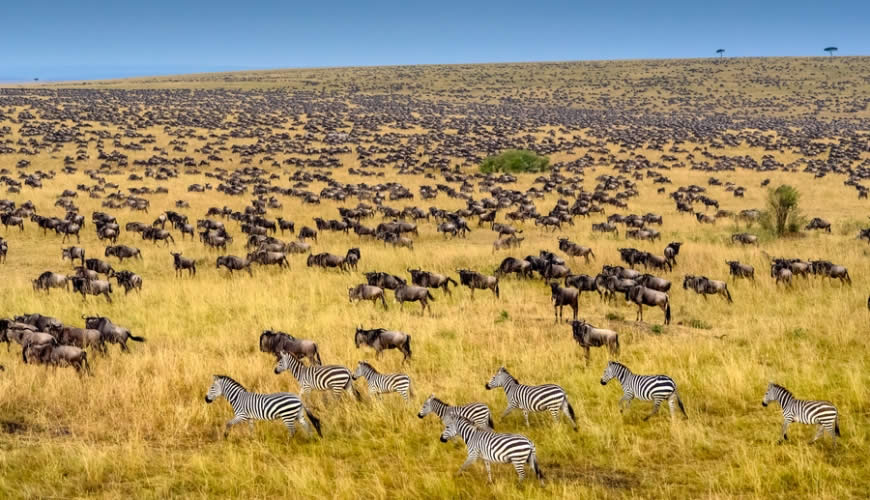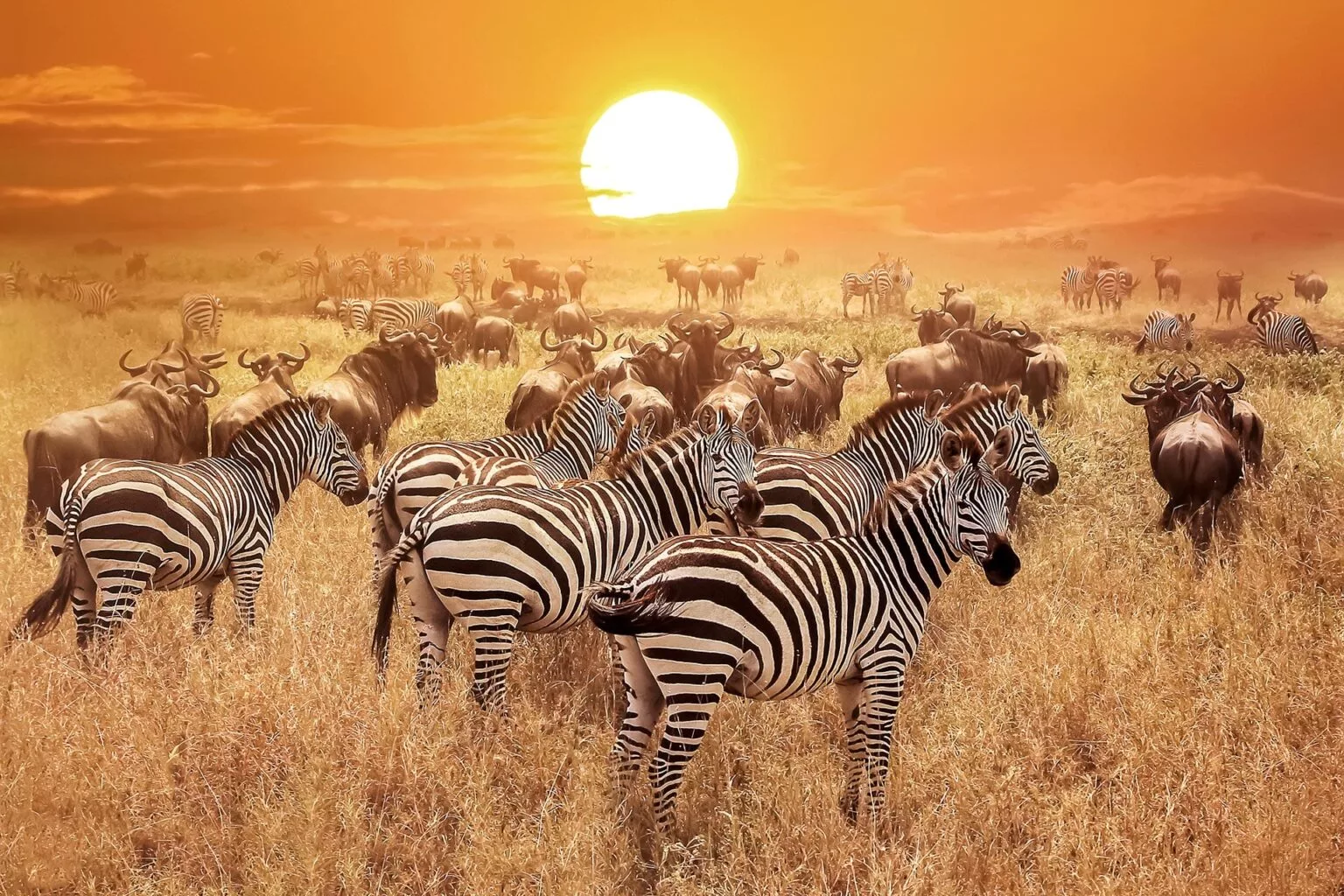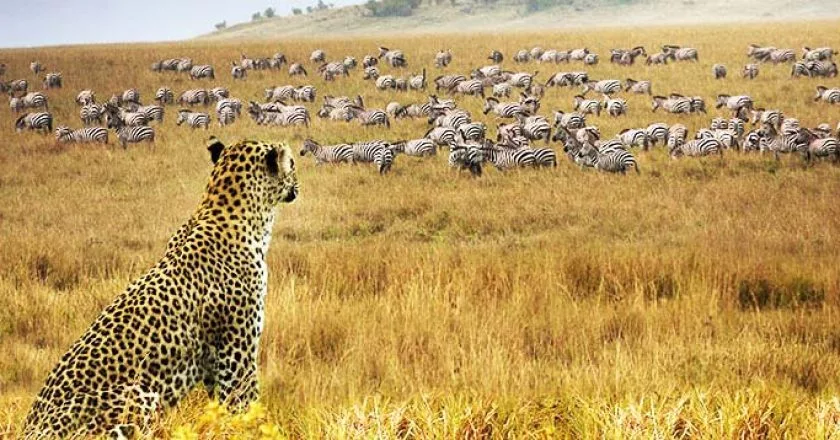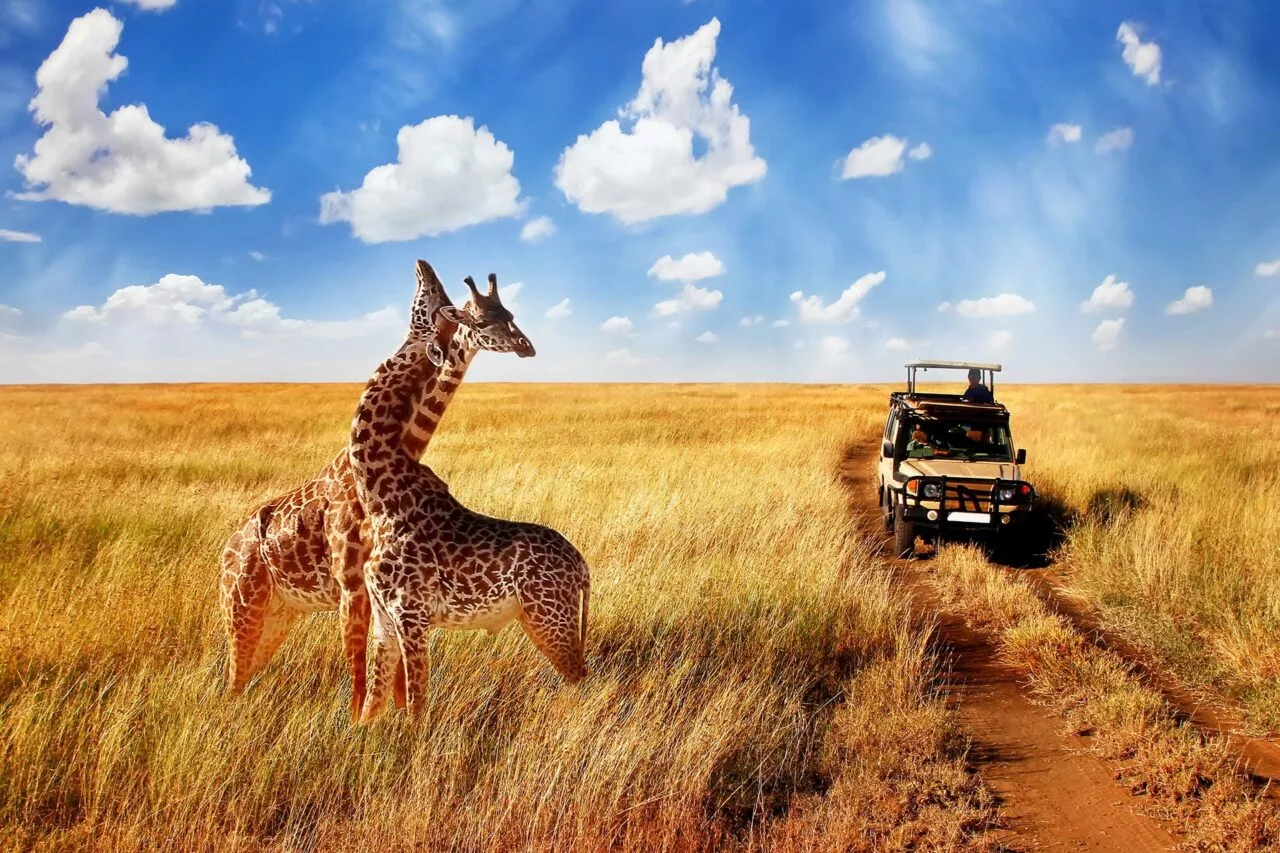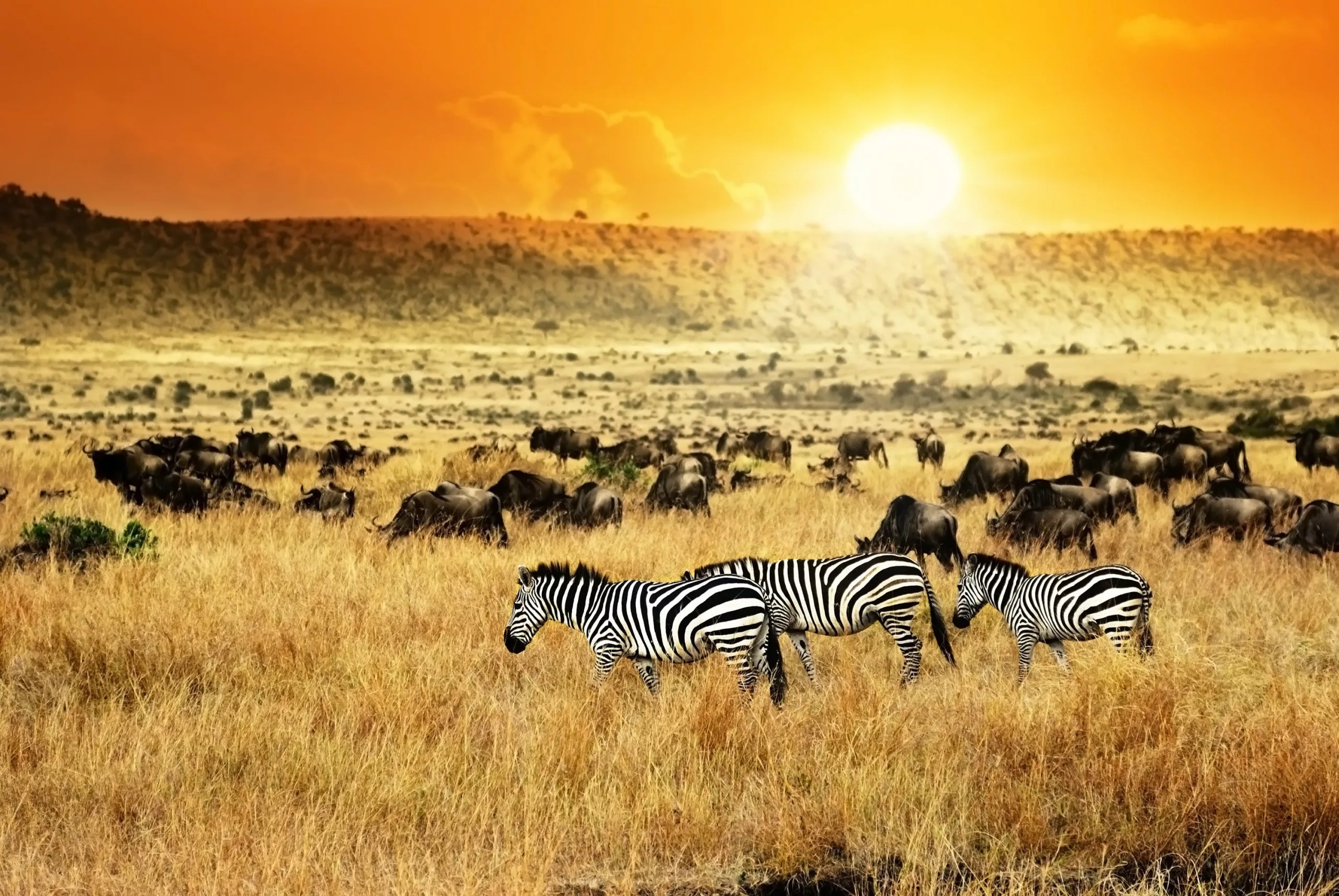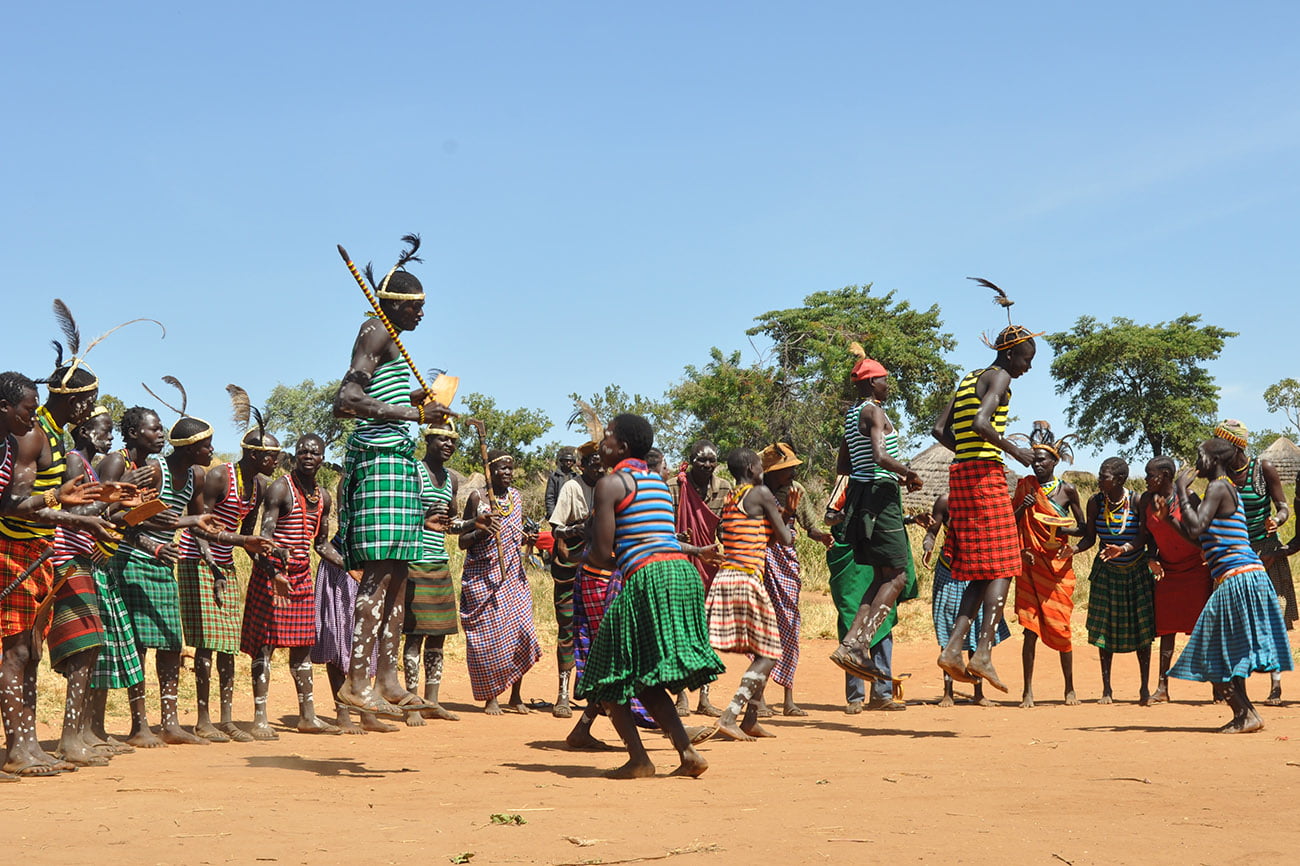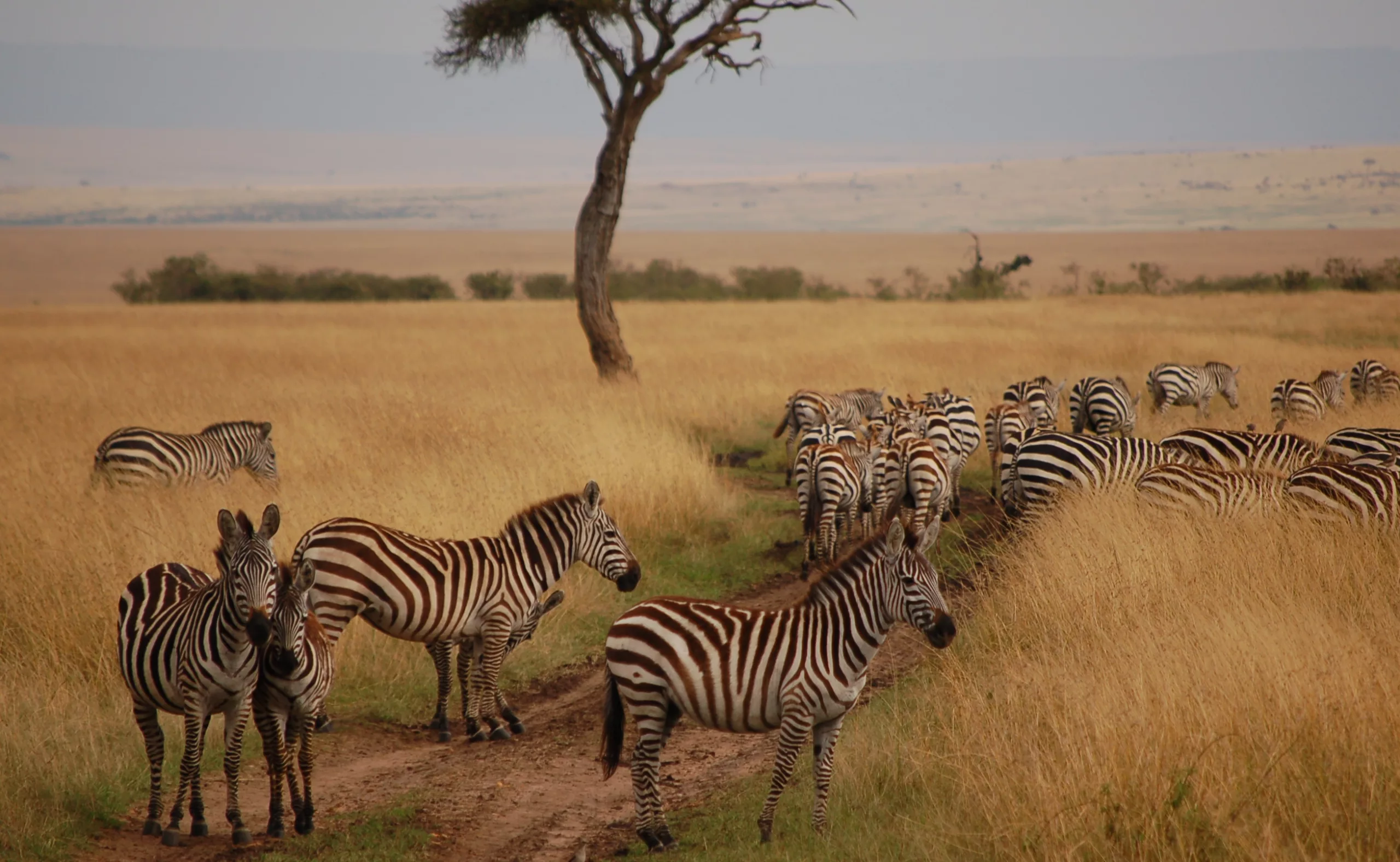A Complete Guide For Serengeti National Park Safari Tanzania
The Great Wildebeest Migration in the Serengeti National Park stands as the world’s largest movement of wild animals, earning its place among the eight Natural Wonders and serving as a prime inspiration for an unforgettable nature expedition through northern Tanzania with Deks Uganda Safaris. Approximately 1.5 million wildebeests, accompanied by hundreds of thousands of zebras, elands, gazelles, and a trailing pack of predators, depart from their calving grounds in the southern Serengeti around March and April, embarking on a journey toward the nearest water source.
The Top 12 Best Selling Tanzania Safari Holidays to Serengeti National Park
5 Days Tanzania Camping Safari
These 5 Days camping safari in Tanzania attracts those who experience its stunning beauty. Four parks are located in Tanzania, an area that has preserved its purity.
6 Days Best Safari in Tanzania
Here are the 6 Days Best Safari in Tanzania in some of Tanzania’s most famous parks. It will give you all the opportunities you want to experience in the park.
8 Days Tanzania Safari Adventure
An iconic 8-day Tanzania safari adventure where you will not only have the opportunity to visit all the parks on the northern Tanzanian safari circuit (including 3 nights.
8 Days Tanzania Safari Tour
Our 8 Days Tanzania Safari, Nature & Culture Tour provides the most comprehensive overview of the country’s parks and culture. You will visit all four of Tanzania’s famous.
8 Days Tanzania Safari & Zanzibar Holiday
Experience the ultimate 8 Days Tanzania Safari Holiday & Zanzibar Beach Tour with culture, wildlife, and white sand beaches packed into one. Relax in Zanzibar, then explore Africa’s national parks before unwinding on the exotic island’s.
9 Days Tanzania Safari and Zanzibar Holiday
This is a 9 Days Bush to Beach Tanzania Safari and Zanzibar tour to the best of the Northern Park of Tanzania, the Serengeti. The parks are home to small and large animals including birds and reptiles. Afterwards, we go game viewing
10 Days Stone Town Zanzibar Safari
The 10 Days Stone Town Zanzibar Sand and Selous Safari Combines Stone Town, a Unesco World Heritage Site, and a beach resort on Zanzibar with 2 nights on safari in Nyerere National Park (formerly Selous) in South Tanzania.
15 Days Tanzania Zanzibar Beach Safari
You will have 15 Days Tanzania Zanzibar Exciting Safari with the aid of this itinerary, seeing all that the nation has to offer—from the breathtaking Serengeti, Tarangire, and Ngorongoro Crater to the unexplored beaches of Zanzibar.
14 Days Zanzibar & Tanzania Wildlife Safari
14 Days Midrange Tanzania Wildlife Safari and Zanzibar Beach Holiday. Immerse yourself in the untouched landscapes as you witness wild animals up close, capturing breathtaking photos of Tanzania’s stunning panoramas.
13 Days Tanzania Zanzibar Beach Safari
This is a 13 Days Tanzania Safari Holiday where you will enjoy the bush and Zanzibar with a chance to see the Great Migration and other interesting animals. All this with the assistance of a tour operator based in Arusha. This 13 Days…
12 Days Tanzania Wildlife & Beach Incredible Safari
This 12 Days Tanzania Incredible Safari is designed for those visitors who want to see what Tanzania offers. You will spend time on Tanzania’s mainland and Zanzibar Island. During the safari, you will witness Tanzania’s Great Annual.
11 Days Tanzania Great Migration Safari
This 11 Days Tanzania Safari Holiday is where you will enjoy the bush safari and Zanzibar beach with a chance to see the Big Five and other interesting animals. All this with the assistance of Deks Uganda Safaris in Arusha. This 11 Days…
Serengeti National Park – Travel Guide, Map & More!
The route takes them through the south-central Seronera outskirts into the Western Corridor and Grumeti River in Serengeti National Park, where they arrive from April to May, lingering until June. From there, they proceed to the Masai Mara National Reserve in Kenya, crossing the treacherous Mara River around July or August, before returning via the same perilous river, this time heading toward Lobo and Loliondo in the eastern Serengeti National Park around October to November.
The white-bearded wildebeest then make their way back to the southern Ndutu calving grounds, with arrivals starting around December and temporary residency lasting until March. The timing of the migration depends on the annual rains and the renewal of fresh pasture, which may vary from year to year. Nonetheless, witnessing this spectacle is a rewarding endeavor, as countless wild gnus traverse the plains, driven by instinct or necessity, acting as a cohesive unit in their pursuit of destiny—to rut, mate, brave challenges, and face death on this incredibly perilous journey, essential for the survival of the wildebeest and the Serengeti National Park ecosystem they sustain.
Serengeti National Park Ecosystem
Their epic journey is one marked by violence and endurance, as they forge ahead, passing granite kopjes where cheetahs or lions lie in wait, navigating flood-swollen rivers teeming with crocodiles, crossing parched plains scorched by wildfires, all to seek refuge in the north. Then, guided by distant rains, they embark on the return journey, confronting even greater hazards, including exhaustion and predators, losing a quarter of their numbers along the way.
To truly grasp the magnitude of this phenomenon, one must participate, tracking and observing from 4×4 game-viewing vehicles, capturing footage from the ground or the air in a hot air balloon, zooming in on the action as if the endless grasslands were a personal theater, with millions of actors performing their ancient ritual for your exclusive viewing.
Serengeti National Park – Travel Guide, Map & More!
- Guide on Serengeti National Park
- Where to Stay In Serengeti National Park
- The Great Wildebeest Migration in Serengeti National Park
- Safari & Tour in Serengeti National Park
- Best Time to Visit Serengeti National Park
- Balloon Safari in Serengeti National Park
- Maasai Tribe of Serengeti National Park
Guide on Serengeti National Park
Serengeti National Park, located in northern Tanzania, is one of Africa’s most iconic and breathtaking wildlife reserves. Spanning over 14,750 square kilometers, it is renowned for its vast savannah plains, teeming with diverse ecosystems and an abundance of wildlife. One of the park’s most notable features is the annual Great Migration, where millions of wildebeest, zebras, and other herbivores traverse the plains in search of fresh grazing grounds, accompanied by predators such as lions, cheetahs, and hyenas. This spectacle of nature is a testament to the park’s significance in preserving biodiversity and supporting complex ecological processes.
Visitors to Serengeti National Park can embark on thrilling safari adventures, offering unparalleled opportunities to witness the Big Five – lions, elephants, buffaloes, leopards, and rhinoceroses – along with a plethora of other wildlife species. Experienced guides lead game drives across the vast expanse of the park, navigating through diverse landscapes ranging from open grasslands to wooded areas and seasonal rivers. Additionally, hot air balloon safaris provide a unique perspective from above, allowing guests to marvel at the breathtaking scenery and observe wildlife from a bird’s-eye view.
Beyond its extraordinary wildlife, Serengeti National Park also holds significant cultural and historical value. The Maasai people, who have coexisted with wildlife in this region for centuries, have a rich cultural heritage deeply intertwined with the land. Visitors have the opportunity to engage with Maasai communities, learning about their traditional customs, ceremonies, and way of life. Conservation efforts within the park prioritize sustainable tourism practices and community involvement, ensuring the preservation of both wildlife and cultural heritage for generations to come. Serengeti National Park stands as a beacon of conservation success and remains a must-visit destination for nature enthusiasts and adventure seekers alike.
Where to Stay In Serengeti National Park?
Choosing where to stay in Serengeti National Park is crucial for optimizing your safari experience and immersing yourself in the breathtaking landscapes and wildlife encounters that the park has to offer. The park boasts a variety of accommodation options catering to different preferences and budgets, ranging from luxury lodges and tented camps to more budget-friendly campsites. Many of these accommodations are strategically located in prime wildlife viewing areas, allowing guests to enjoy close proximity to the park’s most iconic sights and activities.
For those seeking unparalleled luxury and comfort, upscale lodges and tented camps offer an extravagant safari experience amidst the pristine wilderness of the Serengeti. These lodgings often feature spacious suites or tented accommodations equipped with modern amenities, private verandas, and lavish furnishings. Guests can indulge in gourmet cuisine, spa treatments, and personalized Serengeti National Park safari excursions led by expert guides, providing an unforgettable safari adventure combined with the utmost relaxation and opulence.
Alternatively, budget-conscious travelers can opt for more affordable options such as public campsites or mid-range lodges, which provide comfortable accommodations without compromising on the authentic safari experience. These campsites and lodges offer basic amenities such as shared bathroom facilities, communal dining areas, and cozy tented accommodations or chalets. While they may lack the lavish amenities of luxury lodges, they provide an excellent opportunity to connect with nature and immerse oneself in the sights and sounds of the Serengeti without breaking the bank. Whether you choose luxury lodges or budget-friendly campsites, staying within Serengeti National Park ensures an unforgettable safari experience surrounded by the wonders of the African wilderness.
The Great Wildebeest Migration in Serengeti National Park
The Great Wildebeest Migration in Serengeti National Park is one of the most awe-inspiring natural spectacles on the planet, attracting travelers and wildlife enthusiasts from all corners of the globe. Each year, millions of wildebeest, accompanied by zebras, gazelles, and other herbivores, embark on a perilous journey across the vast plains of the Serengeti and Maasai Mara ecosystems in search of fresh grazing lands and water sources. This epic migration spans approximately 1,800 miles and is dictated by the changing seasons, as the animals follow the rains and the growth of nutritious grasses.
The migration unfolds in a dramatic cycle, beginning in the southern Serengeti National Park around December and January, when the wildebeest give birth to their young. As the dry season progresses and the grasslands become depleted, the herds start their northward trek towards the Grumeti River and the Mara River, where they must navigate treacherous crossings filled with lurking crocodiles and other predators.
Witnessing the Great Wildebeest Migration
The sight of thousands of wildebeest plunging into the rivers in a frantic dash to reach the opposite bank is both mesmerizing and heart-pounding, showcasing the raw power of nature and the resilience of these remarkable animals.
Witnessing the Great Wildebeest Migration is an unforgettable experience that offers unparalleled opportunities for wildlife viewing and photography. Safari enthusiasts can embark on guided game drives, hot air balloon safaris, or guided walking safaris to witness the migration up close and observe the interactions between predators and prey. Whether you witness the thundering hooves of the wildebeest herds on the open plains or the heart-stopping river crossings, the Great Migration in Serengeti National Park is a testament to the sheer magnitude and majesty of the natural world, leaving visitors in awe of its beauty and complexity.
Safari & Tour in Serengeti National Park
Embarking on a safari and tour in Serengeti National Park promises an adventure of a lifetime, immersing you in the heart of Africa’s most iconic wildlife sanctuary. The park’s vast expanse offers a multitude of safari experiences, each promising unique encounters with an abundance of wildlife against the backdrop of stunning landscapes.
Your safari adventure typically begins with a game drive, led by experienced guides who possess intimate knowledge of the park’s terrain and wildlife behavior. Whether exploring the endless plains of the southern Serengeti or the wooded hills of the northern reaches, each game drive presents opportunities to spot the Big Five and countless other species, from graceful giraffes to elusive leopards.
For a truly unforgettable experience, consider a hot air balloon safari, offering a bird’s-eye view of the Serengeti’s sweeping landscapes and wildlife gatherings below. Drifting silently above the savannah at dawn, you’ll witness the breathtaking beauty of the sunrise and the park’s inhabitants awakening to a new day.
Hot Air Balloon Safari in Serengeti
In addition to traditional game drives and balloon safaris, guided walking safaris provide a unique perspective, allowing you to immerse yourself in the sights, sounds, and scents of the bush on foot. Accompanied by armed guides, you’ll have the opportunity to track wildlife, learn about the park’s flora and fauna, and gain a deeper appreciation for the intricate ecosystems that sustain life in the Serengeti.
No matter the safari experience you choose, a tour of Serengeti National Park promises moments of wonder, excitement, and connection with the natural world that will leave a lasting impression for years to come. From witnessing the Great Wildebeest Migration to marveling at the sunset over the vast plains, every moment in this legendary wilderness is an adventure waiting to be discovered.
Best Time to Visit Serengeti National Park
The best time to visit Serengeti National Park largely depends on what you hope to experience during your visit, as the park offers different highlights throughout the year.
June to September
For witnessing the Great Wildebeest Migration, considered one of nature’s most remarkable events, the best time to visit is generally from late June to September. During this period, the herds typically gather in the northern Serengeti and cross the Mara River into Kenya’s Maasai Mara, offering spectacular river crossings and predator-prey interactions.
April to May and November to Mid-December
If you prefer fewer crowds and still want to catch the migration, the months of April to May and November to mid-December can be ideal. During these shoulder seasons, you may encounter fewer tourists, and accommodations may offer discounted rates. Additionally, the landscape is lush and green after the rainy season, providing picturesque scenery for photography.
Late June to October
For game viewing in general, the dry season from late June to October offers excellent visibility as the vegetation thins out and animals congregate around water sources. This is also a good time for bird watching, as migrant bird species flock to the park. However, keep in mind that this is peak tourist season, so accommodations tend to book up quickly, and prices may be higher.
Overall, Serengeti National Park is a year-round destination, with each season offering its own unique experiences. Whether you’re after the drama of the Great Migration, the lush landscapes of the green season, or the tranquility of the off-peak months, there’s always something extraordinary to discover in this iconic wilderness.
Balloon Safari in Serengeti National Park
A balloon safari in Serengeti National Park offers a truly unique and unforgettable way to experience the vast plains and abundant wildlife of this iconic destination. As the sun rises over the savannah, you’ll embark on an adventure unlike any other, floating gently above the landscape in a hot air balloon.
The experience typically begins before dawn, as you’re transported from your accommodation to the launch site. Here, you’ll have the opportunity to watch the balloon being inflated and meet your pilot and fellow passengers. Once aboard the balloon basket, the burner ignites, and the balloon gracefully lifts off the ground, offering panoramic views of the Serengeti as it comes to life with the first light of day.
Drifting silently above the savannah, you’ll have the opportunity to witness the breathtaking beauty of the sunrise painting the landscape in golden hues. From your elevated vantage point, you’ll have uninterrupted views of the vast plains stretching out to the horizon, dotted with acacia trees and herds of wildlife below. Your pilot will navigate the balloon over different areas of the park, providing opportunities to spot iconic African animals such as elephants, lions, giraffes, and more from a unique perspective.
As the balloon safari comes to an end, you’ll descend gently back to the ground, where a champagne breakfast awaits. Sip on a glass of bubbly as you reflect on the incredible experience and share stories of the sights you witnessed from above. A balloon safari in Serengeti National Park offers a magical and memorable way to connect with the natural world and create lifelong memories of your time in this legendary wilderness.
Maasai Tribe of Serengeti National Park
The Maasai tribe holds a significant cultural presence in the Serengeti National Park and the surrounding areas. Originating from the Nilotic ethnic group, the Maasai are semi-nomadic pastoralists known for their distinctive customs, attire, and way of life. Despite modernization and changes in land use, many Maasai communities continue to maintain their traditional lifestyle and cultural practices, coexisting with wildlife in the region for centuries.
Visits to Maasai Villages
In the Serengeti National Park, visitors have the opportunity to engage with Maasai communities through cultural experiences and guided tours. Many lodges and camps within and around the park offer cultural visits to Maasai villages, where travelers can interact with community members, learn about their customs, and gain insight into their traditional way of life. These visits often include demonstrations of Maasai dances, songs, and rituals, as well as the chance to visit local markets and handicraft shops showcasing Maasai artistry.
The Maasai’s intimate connection to the land and wildlife is reflected in their deep-seated cultural beliefs and practices. Traditionally, the Maasai have lived in harmony with nature, coexisting with wildlife and relying on their surroundings for sustenance and cultural identity. While modernization and external pressures have posed challenges to their way of life, the Maasai continue to play a vital role in conservation efforts in the Serengeti and beyond, advocating for the preservation of their cultural heritage and the protection of wildlife habitats. As guardians of the land, the Maasai tribe’s presence enriches the cultural tapestry of the Serengeti National Park, offering visitors a deeper understanding of the interconnectedness between humans, wildlife, and the environment.
What Happens in each sector
- North Serengeti National Park
- East Serengeti National Park
- South Serengeti National Park
- West Serengeti National Park
- Central Serengeti National Park
North Serengeti National Park
During the Great Wildebeest Migration, the North Serengeti National Park becomes a vital stage for one of nature’s most incredible spectacles. As the dry season progresses and the herds of wildebeest, zebras, and other herbivores move in search of greener pastures and water sources, they eventually make their way to the northern reaches of the Serengeti.
In the North Serengeti, particularly around the Mara River, the migration reaches its climax with dramatic river crossings. These crossings are iconic and intense as thousands of wildebeest and zebras plunge into the river, braving strong currents and the lurking presence of crocodiles. The sight of the animals navigating the waters en masse, often accompanied by predators such as lions and crocodiles, is both mesmerizing and heart-pounding.
For wildlife enthusiasts and photographers, the North Serengeti National Park offers unparalleled opportunities to witness these dramatic river crossings up close. Tanzania Safaris in this region provide front-row seats to the action, allowing visitors to capture breathtaking images and witness the raw power of nature in action. Beyond the river crossings, the North Serengeti boasts diverse landscapes, including open plains, wooded areas, and hills, providing rich opportunities for game viewing and wildlife encounters throughout the migration season.
Overall, the North Serengeti National Park during the Great Wildebeest Migration is a place of extraordinary beauty and drama, where the cycles of life and death play out against the backdrop of stunning landscapes. It’s a time when nature’s grandeur is on full display, leaving visitors in awe of the sheer magnitude and majesty of the natural world.
East Serengeti National Park
During the Great Wildebeest Migration, the East Serengeti National Park plays a significant role as a transitional area for the massive herds of wildebeest, zebras, and other herbivores. This region, particularly the plains of the Serengeti’s southeastern corner, serves as a critical stopover for the migrating animals as they journey between the southern and northern parts of the park.
In the East Serengeti, the landscape is characterized by vast open plains, dotted with acacia trees and rocky outcrops. During the migration season, these plains become a sea of moving bodies as the herds traverse the area in search of fresh grazing grounds and water sources. The sight of thousands of wildebeest and zebras stretching to the horizon is a testament to the sheer magnitude of the migration and the incredible resilience of these animals.
For visitors to the East Serengeti during the Great Migration, game drives offer exceptional opportunities to witness the spectacle unfold. Expert guides lead safari excursions across the plains, providing insights into the behavior of the migrating herds and helping visitors spot other wildlife species that inhabit the region. Additionally, hot air balloon safaris provide a unique perspective from above, allowing guests to marvel at the vastness of the plains and the scale of the migration from a bird’s-eye view.
Overall, the East Serengeti National Park during the Great Migration is a place of remarkable beauty and biodiversity, where the annual movement of millions of animals transforms the landscape into a living, breathing ecosystem. It’s a time when the rhythms of nature are on full display, captivating visitors with the wonders of the African wilderness.
South Serengeti National Park
The South Serengeti National Park is a region of immense significance within the greater Serengeti ecosystem, particularly during the Great Wildebeest Migration. While not as widely recognized as the northern and eastern parts of the park, the south plays a crucial role in the annual cycle of the migration, offering unique wildlife viewing opportunities and diverse landscapes.
During the dry season, which typically spans from June to October, the South Serengeti becomes a prime destination for witnessing the Great Migration. The region’s vast grasslands provide essential grazing grounds for the migrating herds, attracting millions of wildebeest, zebras, and other herbivores. This creates an incredible spectacle as the plains come alive with the movement of animals stretching as far as the eye can see.
One of the highlights of the South Serengeti National Park during the migration season is the calving season, which typically occurs between January and March. During this time, vast herds of wildebeest gather in the southern plains to give birth to their young. The abundance of newborn calves attracts predators such as lions, cheetahs, and hyenas, creating thrilling wildlife encounters for visitors.
For safari enthusiasts, the South Serengeti offers exceptional game viewing opportunities throughout the year. Guided game drives provide the chance to spot a wide variety of wildlife, including the Big Five – lions, elephants, buffaloes, leopards, and rhinoceroses – as well as cheetahs, giraffes, hippos, and countless bird species. Whether witnessing the drama of the migration or exploring the park’s diverse landscapes and wildlife, a visit to the South Serengeti National Park promises an unforgettable safari experience immersed in the wonders of the African wilderness.
West Serengeti National Park
The West Serengeti National Park is a lesser-known but equally captivating region within the larger Serengeti ecosystem. Characterized by diverse habitats ranging from open plains to woodlands and riverine areas, the west offers unique wildlife viewing opportunities and a quieter, more remote safari experience compared to other parts of the park.
One of the main attractions of the West Serengeti is the Grumeti River, which serves as a vital lifeline for wildlife, particularly during the dry season. As the migrating herds move through the region, the Grumeti River becomes a focal point for dramatic river crossings, similar to those witnessed in the North Serengeti. Crocodiles lurk in the waters, while predators such as lions and hyenas wait patiently on the riverbanks, creating thrilling scenes of predator-prey interactions.
In addition to the river, the West Serengeti National Park is known for its resident wildlife populations, including large herds of buffalo, elephants, giraffes, and antelopes. The region is also home to healthy predator populations, making it an excellent destination for spotting lions, leopards, and cheetahs in their natural habitat. Guided game drives and walking safaris provide opportunities to explore the area’s diverse landscapes and encounter wildlife up close, with knowledgeable guides offering insights into the park’s ecology and conservation efforts.
For visitors seeking a more exclusive safari experience away from the crowds, the West Serengeti National Park offers a tranquil and immersive wilderness adventure. With its stunning scenery, abundant wildlife, and sense of remoteness, a visit to the West Serengeti promises unforgettable moments and lifelong memories in one of Africa’s most iconic safari destinations.
Central Serengeti National Park
Central Serengeti National Park is often considered the heart of the Serengeti and is renowned for its year-round abundance of wildlife, stunning landscapes, and diverse ecosystems. Located between the northern and southern regions of the park, the central area offers a perfect balance of wildlife sightings and beautiful scenery, making it an ideal destination for safari enthusiasts.
One of the main attractions of the Central Serengeti is the Seronera River Valley, a lush and fertile area that supports a rich variety of wildlife throughout the year. The river provides a vital water source, drawing animals from far and wide, including elephants, giraffes, hippos, and a plethora of bird species. Predators such as lions, leopards, and hyenas are also commonly spotted in this area, making for thrilling game viewing experiences.
The Central Serengeti National Park is also famous for its iconic kopjes, massive granite rock formations that dot the landscape. These ancient outcrops provide shelter for wildlife and offer stunning viewpoints for panoramic vistas of the surrounding plains. Visitors can explore these rocky formations on guided game drives or walking safaris, discovering hidden caves, ancient rock paintings, and the fascinating ecosystems that thrive in these unique habitats.
Throughout the year, the Central Serengeti offers excellent game viewing opportunities, with resident wildlife populations ensuring thrilling encounters regardless of the season. Whether witnessing the Great Wildebeest Migration passing through the region or exploring the area’s abundant resident wildlife, a safari in the Central Serengeti National Park promises unforgettable moments and a deep appreciation for the wonders of the African wilderness.
History of Serengeti National Park
The area now known as the Serengeti is grazing land for Maasai cattle, particularly in the eastern Mara region, which is home to a wealth of native wildlife. It became a hunting area in 1913 due to the abundance of animals, and some of the first professional hunters to enter the area included Stuart Edward White, who documented his expeditions into the northern Serengeti in 1913. More than 50 lions were hunted during their stay in the Serengeti.
Recorded during the hunts of Stuart and his companions, lion hunting became rare, prompting the British colonial government to establish a 2-mile (3.2 km) long game reserve. A full reserve was established in 1929, which was a prerequisite for the creation of the Serengeti in 1951. After the area was declared a national park, the Maasai were peacefully driven out of the area and settled in the Ngorongoro Reserve, a matter that remains in question to this day.
Safari Activities in Serengeti National Park
Game Drive
The Serengeti National Park is the most popular and valuable place in Tanzania for wildlife safaris, tours offer the opportunity to explore the four main areas of the Serengeti, namely Seronera, South, Gru Maddy, and the Western Corridor. Game drives at this park offer morning, afternoon, all day, and night game drives. Overall, the Serengeti wildlife safari offers you the opportunity to spot a variety of wildlife that inhabit the Serengeti, such as lions, zebras, leopards, cheetahs, buffaloes, waterbucks, warthogs, kola antelopes, giraffes, hippopotamus, common oryx, pika, pika. , bat-eared fox, painted pangolin, warthog, etc.
Bird watching
Listed as one of the best birding spots in Tanzania, the Serengeti is a birdwatcher’s paradise with over 500 species of birds, making the park a must-see in Tanzania. Bird watching is one of the exciting Tanzanian safari activities that Serengeti National Park offers, allowing you to see a variety of birds including shorebirds, songbirds, and migratory birds from the European and North African regions.
The bird-watching experience starts early in the morning and can last all day if possible. Some of the birds you should see on your Tanzania Bird Tour in Serengeti National Park are Masai Ostriches, Secretary Birds, Cory Bustards, Southern Ground Hornbill, and Crown. crane, black-headed gonolek, marabou stork, yellow-bellied stork, lesser flamingo, black crane, gray thrush, Hartlaub’s turaco, battle eagle, petrel, woodpecker, etc. Bird watching in Serengeti National Park can be done all year round, but the best time is from November to April, which is the breeding season for most of the park’s birds, with migratory birds from Europe and Africa arriving at the park.
How to get to Serengeti National Park
Located in the remote northern corner of Tanzania, the Serengeti is a well-known Tanzanian safari destination and the park is easily and conveniently accessible from Arusha by road or air, depending on the visitor’s preference.
Air Transport
Air Serengeti is accessible by international and regional flights, with the preferred gateway for international flights being Kilimanjaro International Airport, located between Moshi and Arusha, 200 miles from the park’s southern entrance. A regional flight to the Serengeti is a 1–5-hour flight from Kilimanjaro International Airport or Arusha Airport to one of the 9 airstrips serving the park, namely Seronera Airstrip, Grumeti, Lobo, Kleins, Kogatende, Kusini, Ndutu, Kirawira and Sasakwa airstrips.
Go, Overland
Serengeti is about 8 hours’ drive from Arusha and you can use private or public transport. Serengeti National Park has four main entrances and exits namely Naabi Hill Gate, Ndabaka Gate, Klein Gate, and Bologonya Gate.
Accommodation in Serengeti National Park
Serengeti accommodation includes safari lodges, tented camps, seasonal camps, and campsites located in 5 designated settlements. This Park accommodation is divided into luxury, mid-range, and budget categories as shown below. Serengeti lodges include Melia Serengeti Lodge, Nyaruswiga Serengeti Nature Lodge, Simba Lodge Serengeti, Four Seasons Safari Lodge, Elewana Serengeti pionieru nometne, Serengeti Safari Lodge Serengeti, Seronera Wildlife Lodge, Lemala Ewanjan Tented Camp, Mbuzi Mawe Serena Camp utt.


